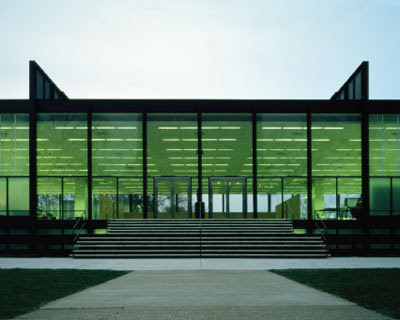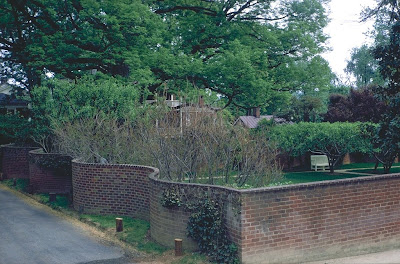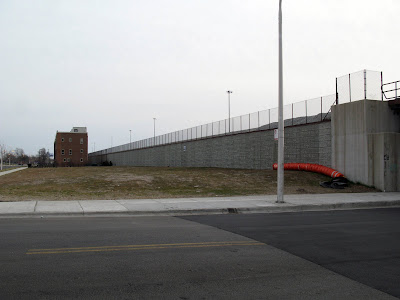Killing Mies Softly
Blair Kamin weighs in today that the Illinois Historic Preservation Agency should allow the demolition of a small building designed by Ludwig Mies van der Rohe- one of the greatest architects of all time. It's worth reading, as Blair always is. But he's wrong.
I wrote about this once before. It's too easy to say that it's okay to tear this down.
It would be simple, using a little creativity and appropriate respect, to not tear down a building and walls by Mies. No one is saying that there should not be a Metra stop near the Illinois Institute of Technology and near White Sox Park and near Bronzeville. No one is against that. But we could have the station and the work by Mies.
More on that at the bottom of this post. Let's put this in context.
---

Each was designed and planned mainly by a single individual, in each case, a recognized genius. The University of Virginia was designed by Thomas Jefferson. The Illinois Institute of Technology by Ludwig Mies van der Rohe.
 Illinois Institute of Technology | Mies van der Rohe, 1940
Illinois Institute of Technology | Mies van der Rohe, 1940Courtesy Mies van der Rohe Archive, Museum of Modern Art, New York
Both campuses are original and great compositions of, and well ahead of, their times. Both men used architecture to foster an Enlightenment agenda and to elevate members of society through education, beauty, harmonic proportions and to rhapsodize on the relation of the individual to the whole-- all to form better democratic citizens.
Each campus contains a masterpiece building within the ensemble. At Virginia, it's the Rotunda, a library, seen above. At the Illinois Institute of Technology (IIT) it's the Architecture school, Crown Hall.

Both of these are protected landmarks and a cry would go up if anyone tried to harm them.
But right now at IIT, a smaller Mies building, and some beautiful walls he designed, are threatened with demolition. The building and those walls strongly contribute to the whole of the campus; they anchor the southwest corner and connect it to the city.
IIT's own website says that what is most important there is the ensemble:
Mies helped develop a comprehensive master plan for the Illinois Institute of Technology campus and designed nearly 20 individual buildings for it, comprising the largest and most important collection of Mies buildings anywhere.It is beautiful, isn't it? An industrial aesthetic, one done with both precision and a sense of the infinite. Mies posited that the spirit of our time is technology (his power plant above has the form of a cathedral and bell tower!) and he invented new honest forms for us to live among.
The sleek lines extend back to infinity. The Test Cell that they want to tear down gives the cathedral-like Power Plant a forecourt, like a cloister. Fine brick walls of varying heights lead your eye to the monument of the power plant, to the great vertical smokestack. These walls provide human scale before the eye reaches the axis mundi. Mies has accomplished this so masterfully you can feel your body be pulled along the wall, even before you physically take the journey. Mies pulls you into the future. Pulls you into modernity. Into an honest yet poetic reckoning of the time we live in.

The building and walls that would be demolished are seen above: The little cubed "shed" on the corner, and the low walls leading from it.
This will probably be torn down by this summer to make way for a Metra commuter train station--unless enough people raise their voices. You can send an email to Metra and to the Illinois Historic Preservation Agency.
The Illinois Historic Preservation Agency maintains that the building was not built to Mies's specifications, and that it has been altered substantially, and thus does not "contribute" to the landmark ensemble.
I wonder what would happen if the University of Virginia (UVA) decided to rip out some of Mr. Jefferson's little brick walls behind the main composition?

Would it be good enough to say, "They're no masterpiece. Just some brick walls."
Virginians and others would raise Cain to stop this. True, they're not the most important thing on campus, but they are part of the ensemble, and that's why they must stay: to help us understand the man's thinking, and the beauty and intelligence of his design. It's the same at IIT, with Mies's walls.
The "less important" buildings around the masterpiece speak of the relationship of society to the individual, or to the leader. One fears that in America today, the "little guy" is not appreciated. Celebrity is what matters--the Crown Hall, or the Rotunda--but not the working person who ultimately makes the grandeur possible. This is what is happening at IIT: the Test Cell is the Detroit autoworker, or the farmer, not the Hollywood movie star. Dispensable in our society, or so we think. Thomas Jefferson would have disapproved.
Architects today speak endlessly of "the edge condition." The interface between two worlds. It could be between the built and natural worlds, or, as in this case, the interface between the campus and the city. That was intensely important to Mies. He wanted an oasis in the city, but of the city and connected to it. He did not wall off the surroundings. The Test Cell shows how he makes that transition.
Edge conditions are often places of conflict and tension. That's what makes them interesting. That's why this one, by Mies, offers lessons on how to resolve them. Mies's famous corner of buildings at IIT show a way to resolve that tension. The Test Cell, likewise, is the corner of the campus.
Do you think this building and walls were not important to the man known for saying, "God is in the details" and "Architecture starts when you carefully put two bricks together. There it begins"? He meant Architecture, the art, as opposed to just "building," which, I'm afraid, is what will replace this.
The new Metra station will be designed by the Chicago office of Skidmore, Owings and Merrill. They have the gumption to allow a Mies to be torn down? They owe their fortune to him and his ideas. They followed his ideas and commercialized them to the point that Skidmore, Owings and Merrill were known as "Three Blind Mies." Are they that blind?
In Mies's work, the detail informs the whole. A little building has an important role on the campus. Like the composer Richard Wagner, Mies is interested in a work of art that totally envelops you and creates a new world for you. In German it's Gesamtkunstwerk and Gesamtkultur. Like Wagner, at IIT Mies repeats motifs and offers variations on a theme. Each part is important to the whole. This is the Bauhaus thinking that Mies, as its last Director in Germany, brought to America.
He developed the curriculum at IIT and had students spend a great deal of time putting bricks together in various fashions. His buildings for the school campus were pedagogical; you learned architecture by looking at how they were constructed. This little Test Cell is where Mies displays a certain brickwork called "running bond." I believe it is the only example of it in Mies's work in America.
Mies is more honest about expressing the role of structure in a building than almost any other architect, and this little thing, unlike the larger buildings on the IIT campus, does not need vertical steel supports.
Mies is more honest about expressing the role of structure in a building than almost any other architect, and this little thing, unlike the larger buildings on the IIT campus, does not need vertical steel supports.
The "Test Cell" building by Mies is a somewhat nondescript building of common materials. That is its importance. Mies's message is that you can take common materials, arrange them as a poet arranges words, and you get an elevated whole, better than the parts. He did not want to work in marble at IIT; part of the message is, common people can come together and form a great society.
After World War Two, the needed low-cost, efficent housing and we were beginning to be honest that ours is an industrial age, not an agrarian one. If Mies had disregarded all that and built in marble, and had underpaid workers make it "pretty;" if Mies had shown off and satisfied egos and built luxuriously, would people be more likely to want to save his work?
Architects today get criticized for having too much ego. Here's an example of architectural modesty. Maybe you can't win.
The difference between IIT with this little building and without is like the difference between watching a complete baseball game, with some boring moments, some strategy and some subtlety; and simply watching highlight home runs on the news. The small moments are what makes the big blast interesting. Look at how Mies uses bricks, on buildings of all sizes, to fully appreciate his home run in glass and steel - Crown Hall.
What's the solution?
Mies's Test Cell stands on the north side of 35th at Federal Street. Metra could put its train station on the south side of 35th street. There's nothing there! No historic cultural pieces to demolish.
![]()

This land is not being developed in this economy and a deal should be worked out to put the station on this site, right across the street from the Mies. Then your millions of visitors to Sox Park would get the million-dollar view of IIT as they exit the station; the Test Cell could be turned into a visitor's center for IIT and Mies and the other exciting architecture on campus, such as works by Rem Koolhaas, Helmut Jahn and Myron Goldsmith.
Locating the station on the south side of Federal would also save the White Sox fans from having to cross that street to get to Sox park, and it does get congested there at game time.
Or Metra could put the station on the west side of the tracks rather than the east side. That's also closer to Sox Park. If it costs a quarter of a million dollars to change the plans, because you weren't sensitive enough at the outset to think that this building that looks like a Mies, on a campus designed by Mies, built at the time Mies building were being built there, is in fact by Mies, then that's your mistake, and Chicago's legacy should not suffer because of it.
At the very least, Metra and IIT could save the Mies structure and incorporate it into the new station. IIT would benefit from millions of people passing through this, learning about Mies, and being encouraged to visit the rest of the campus, including his masterpiece Crown Hall. At the very least, Metra should incorporate the existing structure and to it add something at the artistic level of Mies's IIT campus. Give Chicago something like the Louvre metro stop in Paris, which lets you know you are arriving at special place in world culture.
---
Forty-three years after the bronze-and-glass Seagram Building was finished and thirty-two years after Mies's death, they still can't stop talking about him. There is something about the purity of Mies's buildings, the Platonic perfection they aspire to, that generates awe, even in an age that has no interest in modernism's dreams. Mies's buildings look like the simplest things you could imagine, yet they are among the richest works of architecture ever created. Modern architecture was supposed to remake the world, and Mies was at the center of the revolution, but he was also a counter-revolutionary who designed beautiful things. His spare, minimalist objects are exquisite. He is the only modernist who created a language that ranks with the architectural languages of the past, and while this has sometimes been troubling for his reputation—it seems, falsely, easy to imitate a Mies building, in the same way it seems easy to knock off a Greek temple—his architectural forms become more astonishing as time goes on.
---
When Thomas Jefferson's campus was some sixty years old, about the age of IIT today, it was not admired either. Today no one would think of tearing down anything Thomas Jefferson designed. (Maybe that's also a difference between Virginia and Chicago.)
The irony is that it took the modern movement, with works like those of Mies, to make people find new respect for the work of Jefferson.
The irony is that it took the modern movement, with works like those of Mies, to make people find new respect for the work of Jefferson.
What will it take to get people to appreciate the Modern movement? At least the best of it, such as the work of Mies.
When the Test Cell is gone, IIT will still be there. Crown Hall will still be there. But it's as if we're cutting off a corner of Picasso's Guernica, and replacing it with mediocrity.
.
.

